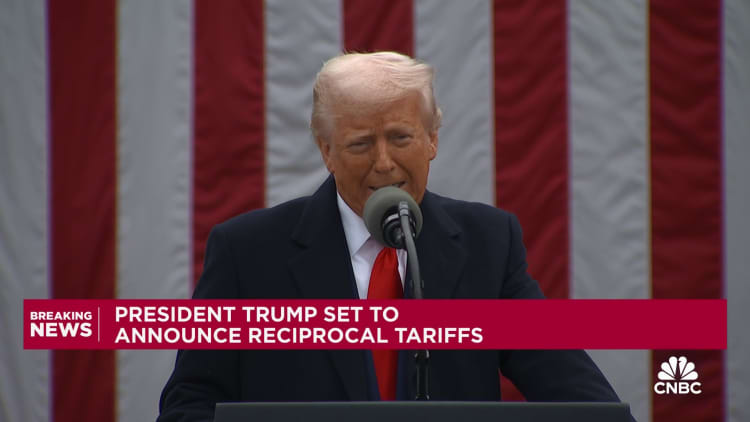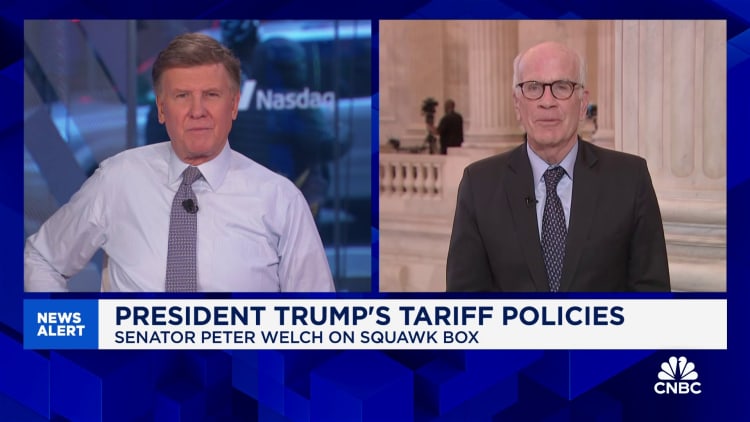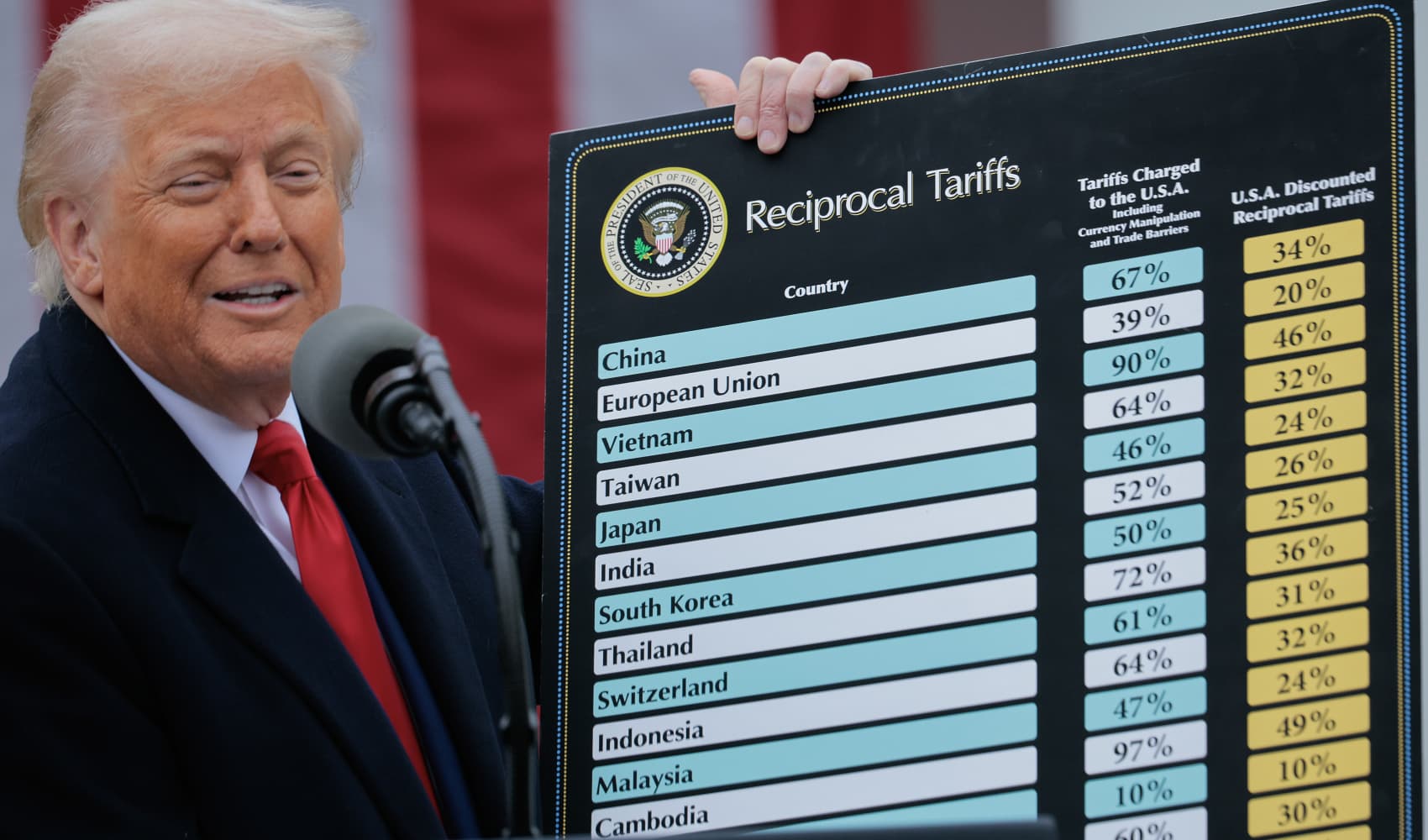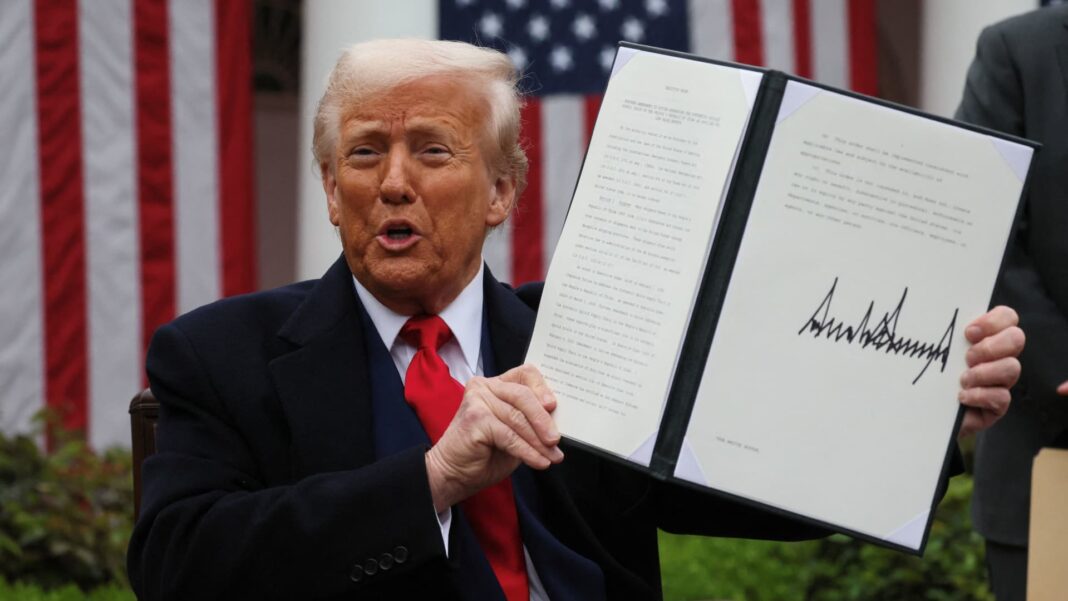## Trump’s Tariff Hammer Falls: Markets Tremble as Businesses Brace for Impact
The air is thick with uncertainty today as President Trump delivers a blow to global trade, announcing higher-than-expected tariffs on Chinese goods. CNBC is providing live updates on the unfolding situation, tracking the market’s volatile response and the potential ripple effects across businesses and industries.

This isn’t just another headline – this is a seismic shift in the trade war, one that could escalate tensions and reshape the economic landscape. We’ll break down the details, analyze the potential impact, and explore what it means for your wallet, your job, and the future of the global economy.

Tariff Calculation Methodology
The White House’s method for calculating tariffs has been a subject of intense scrutiny and analysis, particularly as the global economic landscape braces for the broader implications. At the core of the new tariff strategy is a “halved figure” approach. According to the White House, this approach aims to levy duties that are approximately half of what countries charge the United States. For instance, if a country like China has been imposing tariffs on American goods at a rate of 108%, the White House would apply a 54% tariff on Chinese imports, which is roughly half of the existing rate. This methodology is intended to ensure that the U.S. is not at a competitive disadvantage in international trade.
This approach is not without complexity, as it involves a comprehensive analysis of not only the direct tariff rates but also the “combined rate of all their tariffs, non-monetary barriers and other forms of cheating,” as President Trump specified. This means that the U.S. is factoring in non-tariff barriers such as regulatory barriers, intellectual property enforcement issues, and other trade distortions.

Specific Tariff Rates for Key Countries
Given the complexity of the “halved figure” approach, specific tariff rates for key countries have been meticulously calculated. For China, the most notable example, the effective tariff rate, after accounting for existing tariffs and additional barriers, is 54%. This figure, which is significantly higher than the initial 10% baseline rate, has sent shockwaves through global markets. The impact is not limited to China, as the list of affected countries extends to over 180 nations, each with their own unique tariff rate reflecting the White House’s approach.
The baseline rate of 10% was intended to serve as a starting point, with the expectation that countries with higher existing tariffs would face significantly higher tariffs. This approach targets countries like the European Union, which has its own set of retaliatory tariffs against the U.S., potentially leading to a reciprocal rate of around 30% for European imports. The primary goal is to balance the playing field, although the impact on global trade dynamics is undeniable.

Economic and Market Analysis
Recession Fears and Economic Data
The announcement of higher-than-expected tariffs has significantly contributed to heightened fears of a potential recession. Economic data has shown early signs of a slowdown, with several indicators suggesting that the U.S. economy is under pressure. Recent GDP growth data has indicated a deceleration, falling from 2.1% in the fourth quarter of 2024 to 1.2% in the first quarter of 2025. The Federal Reserve’s latest Beige Book, which compiles anecdotal evidence on economic conditions, notes that the manufacturing sector has slowed, with many companies reporting delays in production and supply chain disruptions due to the uncertainty surrounding trade policies.
Consumer confidence metrics have also taken a hit, with the University of Michigan’s Consumer Sentiment Index showing a decline from 93.7 in February to 83.2 in March, indicating a loss of confidence in the economic future. This sentiment has been exacerbated by the tariff announcements, as consumers brace for potential price increases on imported goods. The fear is that these tariffs could push the economy into a recession, as businesses begin to cut back on investments and hiring, and consumers tighten their belts, reducing discretionary spending.

Inflation and Consumer Impact
The new tariffs are expected to have a significant inflationary impact across various sectors. According to economic projections by the Congressional Budget Office, the new tariffs could add an additional 0.4% to the annual inflation rate in the short term. This projection is based on the assumption that the higher tariffs will increase the cost of imported goods, which will likely be passed on to consumers. Inflation rates have already been rising, with the Consumer Price Index (CPI) showing a 4.8% year-over-year increase in March, a significant rise from 3.9% in February.
The consumer impact is multifaceted. Companies that rely heavily on imported goods, such as retailers and manufacturers, will likely face higher costs. These costs are often passed on to consumers in the form of higher prices. For instance, the apparel and electronics sectors are likely to see the most immediate impact, with products like smartphones and clothing expected to see price hikes. The increased cost of goods could lead to reduced consumer spending, as households allocate more of their budget to basic necessities and less to discretionary spending. This shift in consumer behavior could further slow economic growth, creating a vicious cycle of reduced economic activity and higher prices.

Policy and Strategic Considerations
Trump Administration’s Tariff Strategy
The Trump administration’s tariff strategy is rooted in a dual objective: to level the playing field in international trade and to exert pressure on trading partners to negotiate more favorable terms. The administration believes that the current trade imbalances are due to unfair practices by other countries, including high tariffs and non-tariff barriers that hinder American exports. By implementing reciprocal tariffs, the administration aims to force other nations to the negotiating table with a more balanced approach.
However, the strategy is not without risks. The decision to apply a “halved figure” approach to tariffs is intended to be punitive but not punitive enough to cause immediate economic collapse. The administration aims to use tariffs as a tool for negotiation rather than a permanent solution, thereby creating the potential for future trade agreements that are more favorable to American interests. The strategy involves a phased approach, with the baseline 10% tariff applied first, followed by higher rates as negotiations progress. The goal is to use tariffs as a lever to extract concessions from other nations.
Next Steps and Potential Countermeasures
With the new tariffs in place, the next steps for affected countries will likely include a mix of retaliatory measures and diplomatic efforts. Affected countries, particularly those with significant trade ties to the U.S., such as China, the European Union, and Japan, are expected to respond with their own tariff hikes or other trade barriers. For instance, the European Union may implement retaliatory tariffs on American goods, targeting sectors such as agriculture and automotive, which are critical to U.S. exports to Europe. China, too, could escalate tensions by increasing tariffs on American goods, particularly in the tech and manufacturing sectors.
Possible countermeasures include the use of World Trade Organization (WTO) dispute resolution mechanisms, diplomatic talks, and potential trade deals. Countries may also seek to diversify their trade relationships, exploring new markets to mitigate the economic impact of U.S. tariffs. For example, China might strengthen trade ties with other Asian nations and seek closer economic partnerships with Russia and other emerging markets to reduce its dependency on the U.S. market.
Future Outlook and Market Sentiment
Market Sentiment and Trading Outlook
The markets’ immediate reaction to the tariff announcement has been one of significant volatility. U.S. stock futures cratered as investors processed the implications of the new tariffs, with the S&P 500 futures dropping by 2.8%, Nasdaq-100 futures by 3.06%, and Dow Jones Industrial Average futures falling by 2.33%. The broader market sentiment is one of uncertainty and concern, as traders grapple with the potential long-term effects of these tariffs on global trade and economic growth. The S&P 500, having risen for three consecutive days on the expectation of milder tariffs, is now expected to fall back into a correction territory, with the index likely to drop below the 10% threshold from its recent peak.
Analysts predict that the short-term outlook is grim, with the potential for further market declines and increased volatility. The long-term outlook is equally uncertain, as the tariffs could lead to prolonged economic stagnation if other countries retaliate, potentially triggering a global trade war. Market sentiment is expected to worsen, as companies and investors become increasingly cautious about future economic conditions and the prospects for recovery.
Economic Indicators and Indicators for Recovery
Economic indicators are beginning to show signs of stress, with indicators like the Philadelphia Fed’s Manufacturing Survey and the ISM Manufacturing Index declining in recent months. The decline in these indicators points towards a slowdown in manufacturing activity, which is a critical sector for economic growth. The latest data from the Federal Reserve Bank of Philadelphia shows a drop in manufacturing activity, indicating that businesses are cutting back on production due to uncertainty and increased costs.
Indicators for recovery are currently mixed, with some analysts suggesting that a recovery could begin once trade tensions ease and negotiations yield fruitful results. However, the immediate impact of the tariffs will likely outweigh any potential recovery signals in the near term. Key economic indicators such as the unemployment rate and consumer spending will be closely watched for signs of resilience or further decline. The outlook remains grim, with many experts predicting that the road to economic recovery will be long and fraught with challenges, including the need for substantial policy adjustments and international cooperation.
Conclusion
Conclusion:
In the wake of President Trump’s historic announcement to impose higher-than-expected tariffs, markets have indeed taken a sharp turn. The United States is now facing the ultimate test of its economic resilience, as the world waits with bated breath to see how this move will unfold. The implications of tariffs on trade are far-reaching, affecting not just the US economy but also the global supply chain and the well-being of consumers worldwide. As the situation continues to unfold, one thing is clear: the consequences of this move will be felt for years to come.
The significance of this move cannot be overstated. On the one hand, tariffs can be a powerful tool for protecting American industries and jobs. However, the risks associated with such a move cannot be underestimated. A sharp increase in tariffs could lead to retaliatory measures from other countries, sparking a full-blown trade war that would have far-reaching effects on the global economy. On the other hand, even if tariffs do not lead to a full-blown trade war, they can still have a significant impact on businesses and individuals who rely on international trade.
As the world watches with bated breath, one thing is certain: the world will not be the same without the United States. The implications of this move will be felt for years to come, and it is essential that policymakers and leaders take decisive action to mitigate the risks associated with this move. Will the Trump administration be able to navigate the complexities of tariffs and emerge with a more favorable outcome? Only time will tell, but one thing is certain: the world will be watching with great interest.

